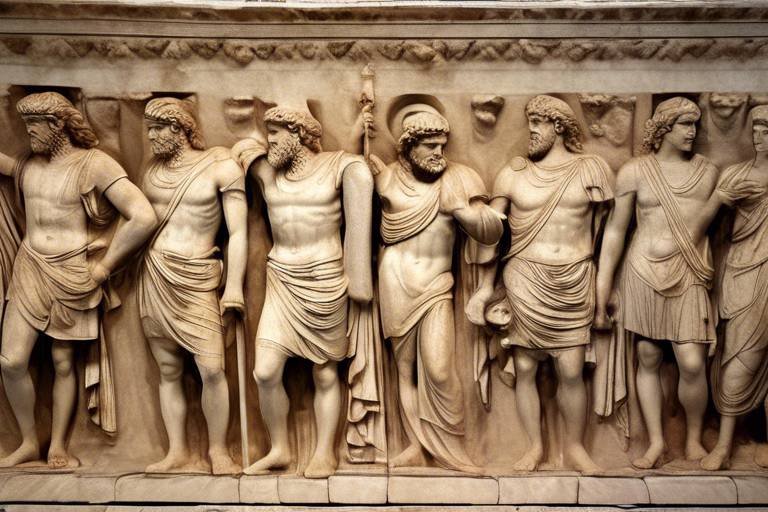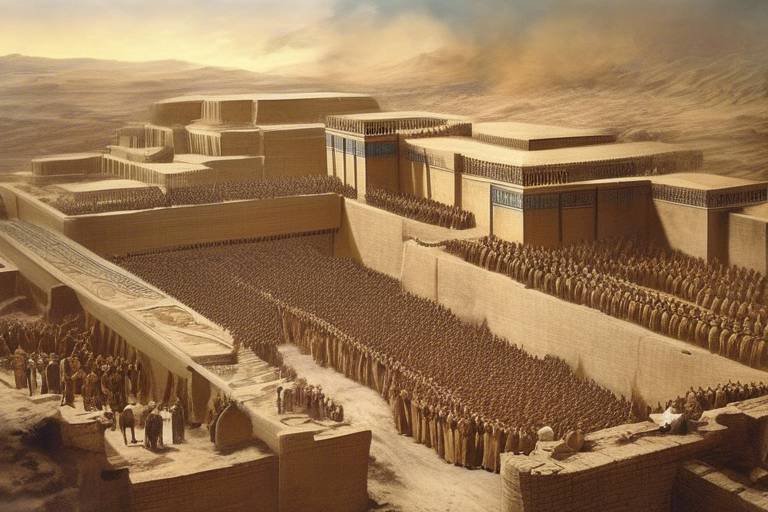The Decline of the Byzantine Empire - Causes and Consequences
Exploring the factors that led to the decline of the Byzantine Empire and the lasting impact it had on history.
The Byzantine Empire, once a powerful and influential civilization, faced a multitude of challenges that ultimately led to its downfall. Internal struggles plagued the empire, with constant power struggles, corruption, and weak leadership weakening its foundations. The lack of unity and stability within the ruling elite created a breeding ground for chaos and disarray, setting the stage for external invasions to exploit the empire's vulnerabilities.
External invasions, particularly by the Ottoman Turks and Crusaders, posed a significant threat to the Byzantine Empire's security and resources. The relentless attacks on its borders stretched the empire's defenses thin, draining its military and economic strength. The constant pressure from external forces further exacerbated the internal turmoil, pushing the empire towards a state of perpetual crisis.
Economic challenges also played a pivotal role in the decline of the Byzantine Empire. The empire's economy faced instability due to high taxes, rampant inflation, and disruptions in trade routes. The financial strain placed on the empire hindered its ability to maintain a strong military presence and invest in crucial infrastructure, leaving it vulnerable to both internal and external threats.
Religious schisms further divided the Byzantine Empire, weakening its social fabric and undermining its unity. The Great Schism between the Eastern Orthodox Church and the Roman Catholic Church created deep rifts within the empire, sowing seeds of discord that would ultimately contribute to its downfall. The religious conflicts added another layer of complexity to the empire's already fragile state, making it difficult to achieve internal cohesion.
The gradual loss of key territories, such as Anatolia and the Balkans, dealt a severe blow to the Byzantine Empire's power and influence. As these territories fell into the hands of rival powers, the empire's territorial integrity crumbled, further diminishing its ability to project strength and authority. The loss of strategic regions weakened the empire's position in the region, hastening its decline.
Technological stagnation also played a role in the Byzantine Empire's downfall. The empire's failure to adapt to new military technologies and advancements put it at a disadvantage against more innovative and adaptive enemies. The lack of technological progress hindered the empire's military capabilities, leaving it ill-equipped to defend itself against the evolving threats it faced.
Despite its decline, the Byzantine Empire's cultural, artistic, and architectural legacy endured, leaving a lasting impact on future civilizations. The empire's rich cultural heritage, characterized by intricate mosaics, monumental architecture, and religious art, continued to inspire and influence artistic movements for centuries to come. The Byzantine legacy transcended its political demise, shaping the cultural landscape of the Mediterranean world and beyond.
The fall of Constantinople in 1453 to the Ottoman Empire marked the final chapter in the decline of the Byzantine Empire and the end of an era. The conquest of the imperial capital symbolized the end of Byzantine sovereignty and the beginning of a new chapter in world history. The fall of Constantinople reverberated across Europe, signaling the end of the Middle Ages and the dawn of a new era dominated by emerging powers.

Internal Struggles
Exploring the factors that led to the decline of the Byzantine Empire and the lasting impact it had on history.
Internal power struggles, corruption, and weak leadership within the empire contributed significantly to its decline. The Byzantine Empire faced numerous challenges from within, as ambitious nobles vied for power, leading to instability and a lack of cohesion in governance. Corruption seeped into the highest echelons of authority, undermining the effectiveness of policies and eroding public trust. Weak leadership further exacerbated these internal struggles, as rulers failed to unite the empire and address pressing issues.
Additionally, the fragmentation of power centers within the Byzantine Empire hindered decision-making processes and impeded swift responses to external threats. The lack of a unified vision and concerted action weakened the empire's ability to withstand the pressures it faced. These internal conflicts sapped the empire's strength and resilience, leaving it vulnerable to external aggressors.
Despite the empire's rich cultural and historical heritage, internal discord and power struggles ultimately hastened its decline. The inability to resolve these internal challenges weakened the Byzantine Empire from within, paving the way for its eventual downfall.
- What were the main causes of the decline of the Byzantine Empire?
- How did the fall of Constantinople impact the Byzantine Empire?
- What was the legacy of the Byzantine Empire despite its decline?
The decline of the Byzantine Empire was primarily caused by internal power struggles, external invasions, economic challenges, religious schisms, loss of territory, and technological stagnation.
The fall of Constantinople in 1453 to the Ottoman Empire marked the final chapter in the decline of the Byzantine Empire, leading to the end of an era and the loss of a significant stronghold.
Despite its decline, the Byzantine Empire left behind a lasting legacy in terms of cultural, artistic, and architectural contributions that continued to influence future civilizations.

External Invasions
Exploring the factors that led to the decline of the Byzantine Empire and the lasting impact it had on history.
External invasions played a crucial role in the weakening of the Byzantine Empire. The constant onslaught of external forces, such as the Ottoman Turks and the Crusaders, posed a significant threat to the empire's stability. These invasions not only put immense pressure on the empire's defenses but also drained its valuable resources.
The Ottoman Turks, known for their military prowess, launched relentless attacks on Byzantine territories, gradually encroaching upon key regions. The Crusaders, driven by religious zeal and the desire for conquest, further exacerbated the empire's vulnerabilities. These external invasions not only resulted in territorial losses but also inflicted heavy casualties on the Byzantine forces.
Moreover, the frequent incursions disrupted trade routes, leading to economic hardships for the empire. The Byzantine Empire struggled to cope with the continuous external threats, which strained its military capabilities and administrative structure.
Despite valiant efforts to repel these invasions, the Byzantine Empire found itself increasingly isolated and weakened on the international stage. The relentless external pressure ultimately played a pivotal role in the empire's eventual decline and fall.
1. What were the major external threats faced by the Byzantine Empire?
2. How did external invasions contribute to the decline of the Byzantine Empire?
3. What impact did the Ottoman Turks and the Crusaders have on Byzantine territories?
4. How did economic disruptions caused by external invasions affect the Byzantine Empire?

Economic Challenges
Exploring the factors that led to the decline of the Byzantine Empire and the lasting impact it had on history.
Internal power struggles, corruption, and weak leadership within the empire contributed significantly to its decline.
Constant invasions by external forces, such as the Ottoman Turks and the Crusaders, weakened the empire's defenses and resources.
Economic instability, including high taxes, inflation, and trade disruptions, further strained the Byzantine Empire's resources.
The economic challenges faced by the Byzantine Empire played a crucial role in its decline. High taxes imposed on the population, coupled with rampant inflation, created significant financial burdens for both the state and its citizens. Trade disruptions, caused by conflicts and invasions, further exacerbated the economic instability within the empire. These challenges not only weakened the empire's financial foundation but also hindered its ability to sustain its military and administrative structures effectively.
Religious conflicts, such as the Great Schism between the Eastern Orthodox Church and the Roman Catholic Church, divided the empire internally.
Gradual loss of key territories, including Anatolia and the Balkans, diminished the Byzantine Empire's power and influence.
Failure to adapt to new military technologies and advancements put the Byzantine Empire at a disadvantage against its enemies.
Despite its decline, the Byzantine Empire's cultural, artistic, and architectural legacy continued to influence future civilizations.
The fall of Constantinople in 1453 to the Ottoman Empire marked the final chapter in the decline of the Byzantine Empire and the end of an era.
If you have any questions related to the decline of the Byzantine Empire, its causes, consequences, or legacy, check out the following FAQs:
- What were the main internal struggles that contributed to the decline of the Byzantine Empire?
- How did external invasions weaken the Byzantine Empire?
- What economic challenges did the Byzantine Empire face?
- How did religious schisms impact the internal stability of the empire?
- What territories did the Byzantine Empire lose over time?
- Why was the fall of Constantinople significant in the history of the Byzantine Empire?

Religious Schisms
Religious Schisms played a crucial role in the decline of the Byzantine Empire. The Great Schism of 1054, which led to the split between the Eastern Orthodox Church and the Roman Catholic Church, created deep divisions within the empire. This religious conflict not only weakened the unity of the Byzantine Empire but also strained its relationships with Western powers.
Furthermore, theological disputes over doctrinal differences added fuel to the fire of religious tensions. The Byzantine Empire faced internal turmoil as debates over religious practices and beliefs intensified. The religious schisms not only fractured the empire but also diverted attention and resources away from addressing external threats.
The religious divisions also had political implications, as the Byzantine Emperor's authority was intertwined with the church. The power struggle between secular and religious authorities further destabilized the empire, making it more vulnerable to external invasions.
Moreover, the religious schisms had long-lasting consequences on the Byzantine Empire's relations with other Christian states. The rift between the Eastern Orthodox Church and the Roman Catholic Church hindered potential alliances and cooperation, weakening the empire's diplomatic standing on the international stage.
In conclusion, the Religious Schisms within the Byzantine Empire exacerbated existing internal conflicts and weakened its unity, contributing significantly to its overall decline. The religious divisions not only affected the empire's internal stability but also had far-reaching consequences on its external relations and geopolitical standing.

Loss of Territory
The loss of territory played a pivotal role in the decline of the Byzantine Empire, gradually eroding its power and influence over time. Key regions such as Anatolia and the Balkans slipped from Byzantine control, weakening the empire's strategic position and access to vital resources. This territorial loss not only diminished the empire's military capabilities but also strained its economic stability as valuable lands fell into the hands of rival powers.
As neighboring states and empires encroached on Byzantine territories, the empire faced constant pressure to defend its borders and maintain control over key regions. The gradual erosion of its territorial holdings left the Byzantine Empire vulnerable to external threats and internal unrest, further exacerbating its decline. The loss of Anatolia, known as Asia Minor in ancient times, was particularly significant as it had long been considered the heartland of the Byzantine Empire.
The strategic importance of the Balkans, a region rich in resources and trade routes, cannot be understated in the context of the Byzantine Empire's decline. As Byzantine control over the Balkans waned, the empire lost access to crucial economic assets and faced increased competition from neighboring powers vying for dominance in the region. The loss of key territories not only weakened the Byzantine Empire militarily but also diminished its cultural and political influence in the broader Mediterranean world.
Despite efforts to reclaim lost territories through military campaigns and diplomatic negotiations, the Byzantine Empire struggled to reverse the tide of territorial decline. The loss of Anatolia and the Balkans represented a significant blow to the empire's prestige and power, signaling the beginning of a protracted period of decline that would ultimately culminate in the fall of Constantinople and the end of the Byzantine Empire as a major political entity.
Q: What were the main factors that contributed to the decline of the Byzantine Empire?
A: The decline of the Byzantine Empire was influenced by internal power struggles, external invasions, economic challenges, religious schisms, loss of territory, and technological stagnation.
Q: How did the loss of territory impact the Byzantine Empire's decline?
A: The loss of key territories such as Anatolia and the Balkans weakened the empire's military capabilities, strained its economic resources, and diminished its political influence, contributing significantly to its overall decline.
Q: What was the significance of the fall of Constantinople in 1453?
A: The fall of Constantinople to the Ottoman Empire marked the final chapter in the decline of the Byzantine Empire, leading to the end of Byzantine rule and the beginning of a new era in the history of the region.

Technological Stagnation
Exploring the factors that led to the decline of the Byzantine Empire and the lasting impact it had on history.
During its later years, the Byzantine Empire faced a significant challenge in terms of technological stagnation. The empire failed to keep up with advancements in military technology, which ultimately put it at a disadvantage against its enemies. While other civilizations were embracing new innovations in warfare, the Byzantines struggled to adapt, leading to a decline in their military capabilities.

Legacy of the Byzantine Empire
Exploring the factors that led to the decline of the Byzantine Empire and the lasting impact it had on history.
The Byzantine Empire, despite its eventual decline, left a profound legacy that continues to shape the world today. This legacy is not merely confined to the pages of history but is ingrained in the very fabric of modern civilization.
One of the most significant aspects of the Byzantine legacy is its cultural influence. The empire's rich artistic traditions, blending Greek, Roman, and Eastern influences, laid the foundation for the artistic achievements of future generations. Byzantine art, with its intricate mosaics, iconic religious paintings, and majestic architecture, inspired artists throughout the Renaissance and beyond.
Furthermore, the Byzantine Empire played a crucial role in preserving and transmitting ancient knowledge. Byzantine scholars meticulously copied and preserved classical texts, ensuring that the wisdom of the ancient world was not lost to the sands of time. This intellectual legacy paved the way for the intellectual flourishing of the Renaissance and the Scientific Revolution.
Moreover, the Byzantine Empire's enduring impact can be seen in the realm of religion. The Eastern Orthodox Church, which traces its roots to the Byzantine era, continues to be a major branch of Christianity with millions of followers worldwide. The theological debates and doctrinal developments that took place within the Byzantine Empire continue to influence theological discussions within Christianity.
Architecturally, the Byzantine Empire's innovations, such as the construction of the Hagia Sophia, set new standards for grandeur and beauty in building design. The domed churches and palaces of Constantinople served as architectural marvels that inspired future generations of builders and architects.
Lastly, the Byzantine Empire's legacy extends to the political realm as well. The concept of a centralized imperial authority, bureaucratic administration, and a system of laws and governance established by the Byzantines influenced the development of later European states. The Byzantine model of governance served as a blueprint for the medieval kingdoms and empires that emerged in the wake of its decline.
In conclusion, the Byzantine Empire may have fallen, but its legacy endures in the realms of art, culture, religion, architecture, and politics. The impact of this once-mighty empire continues to reverberate through the corridors of history, reminding us of the enduring power of human creativity and innovation.

Fall of Constantinople
The Fall of Constantinople in 1453 marked a pivotal moment in history, signaling the end of the Byzantine Empire and the beginning of a new era under Ottoman rule. The city, known for its strategic location and formidable defenses, had withstood numerous sieges over the centuries. However, in the spring of 1453, the Ottoman forces, led by Sultan Mehmed II, launched a massive assault on the city.
Constantinople, once considered impregnable, faced relentless attacks from the Ottomans who utilized advanced military tactics and powerful cannons. The Byzantine defenders, outnumbered and exhausted, fought bravely but were ultimately overwhelmed by the sheer force of the Ottoman army.
As the walls of Constantinople crumbled under the relentless barrage of cannon fire, the fate of the city was sealed. On May 29, 1453, after a fierce battle that lasted for over a month, the Ottomans breached the city's defenses and entered Constantinople, bringing an end to the Byzantine Empire.
The fall of Constantinople had far-reaching consequences, not only for the Byzantine Empire but for the entire region. The conquest of the city marked the beginning of Ottoman dominance in the Eastern Mediterranean and the Balkans, shaping the course of history for centuries to come.
With the fall of Constantinople, the Byzantine Empire, once a powerful and influential force in the world, came to an abrupt and tragic end. The legacy of the empire, however, lived on through its art, architecture, and culture, which continued to inspire and influence future generations.
Frequently Asked Questions
- What were the main internal struggles that contributed to the decline of the Byzantine Empire?
The Byzantine Empire faced internal power struggles, corruption, and weak leadership, all of which played a significant role in its decline. These factors weakened the empire from within, making it vulnerable to external threats.
- How did external invasions impact the Byzantine Empire?
Constant invasions by external forces, such as the Ottoman Turks and the Crusaders, posed a serious threat to the Byzantine Empire. These invasions weakened the empire's defenses and drained its resources, contributing to its eventual downfall.
- What were some of the economic challenges faced by the Byzantine Empire?
The Byzantine Empire struggled with economic instability, including high taxes, inflation, and trade disruptions. These challenges strained the empire's resources and made it difficult to maintain its power and influence.
- How did religious schisms affect the Byzantine Empire?
Religious conflicts, such as the Great Schism between the Eastern Orthodox Church and the Roman Catholic Church, divided the Byzantine Empire internally. These divisions weakened the empire's unity and contributed to its decline.
- What territories did the Byzantine Empire lose over time?
The Byzantine Empire gradually lost key territories, including Anatolia and the Balkans. These losses diminished the empire's power and influence, making it more vulnerable to external threats.
- How did technological stagnation impact the Byzantine Empire?
The Byzantine Empire's failure to adapt to new military technologies and advancements put it at a disadvantage against its enemies. This technological stagnation weakened the empire's military capabilities and made it more susceptible to attacks.
- What is the legacy of the Byzantine Empire despite its decline?
Despite its decline, the Byzantine Empire left a lasting legacy in terms of culture, art, and architecture. Its influence continued to shape future civilizations long after its fall, showcasing the empire's enduring impact on history.
- What significance does the fall of Constantinople hold in the history of the Byzantine Empire?
The fall of Constantinople in 1453 to the Ottoman Empire marked the final chapter in the decline of the Byzantine Empire. It symbolized the end of an era and the loss of one of the empire's most important cities, signaling the complete collapse of Byzantine power.



















